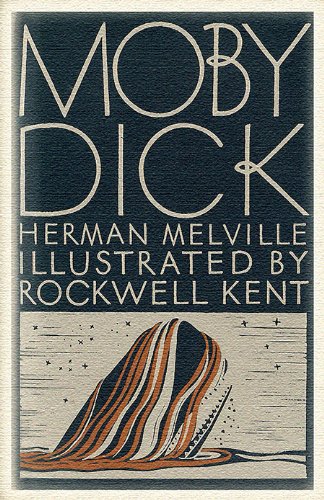
This is the colorized cover of the Kindle edition of Herman Melville’s “Moby-Dick” as illustrated by Rockwell Kent for the 1930 edition, but with the author’s name added. (see below)
Well, I gotta right to sing the blues, Or to sing praises, like a fool, to the earthly heavens where art might come from. And if it is the blues, it’s the kind that inspires you rather than keeps your head just above water.
You see, my song sort of went on and on (by Facebook comment standards), spilling over the 12-bar blues form like water in a sinking ship. But the editors at PBS American Masters Facebook page didn’t jettison any of my load of responses to the provocative question: What single work of art changed your life?
They’ve received 247 responses and counting. Here’s my response. I couldn’t quite help myself. I have even expanded on it here, with a bit more text and imagery.
___
As a long-time generalist arts journalist, I’ve encountered so much extraordinary art in all its forms. How to pick one? I might say seeing Picasso’s “Guernica,” but it was an oddly truncated experience, as the Metropolitan Museum of Art closed before I could see all of it. I’d literally been stopped in my tracks on the staircase for long minutes because the center of Guernica filled the doorway view at the top. Then the doors closed, as the museum was closing for the day. I didn’t have time to return before flying back home. The great work moved to Spain a short time later, in 1981. So, I live with a reproduction of it, and that oddly but profoundly unfulfilled experience. 1
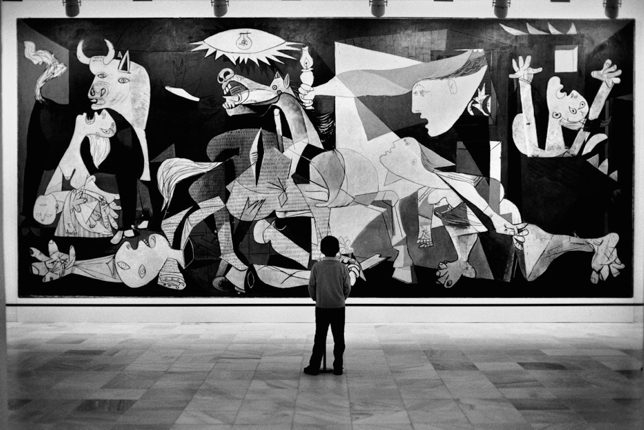
Imagine seeing, through a doorway, the middle of this astonishing political mural by Picasso, being stopped in your tracks by it on a museum staircase — and then the gallery doors closing on you at 5 p.m. That’s my sadly truncated but unforgettable experience of seeing the mighty “Guernica.” Courtesy Magazine Artsper
“Guernica,” of course was named for the Spanish town bombed in 1937 by Nazi planes, complicit with Fascist dictator Franco — the first act of modern war terrorism on a civilian population of nascent World War II.
***
And then, seeing Arshile Gorky’s often-gorgeous metamorphosis from surrealism to abstract-expressionism — closely reflecting my own artistic sensibilities — at the Guggenheim Museum of Art is another life-changing moment.
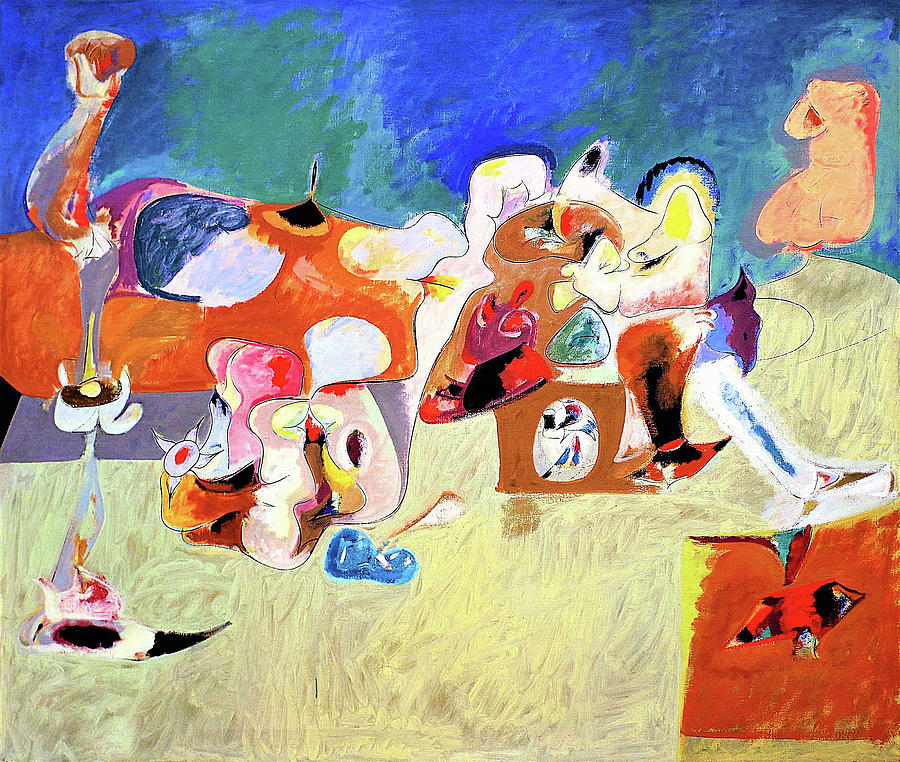
Arshile Gorky’s 1946 painting “The Plow and the Song,” (above) lyrically transmutes his memories of homeland Armenia to the modernist present. The memories were rooted in his long, desperate childhood escape, by foot, with his sister Vartoosh and mother, from the Armenian holocaust conducted by the Ottoman Empire. Their mother, Sushan der Marderosian pictured below — in this wrenchingly poignant Gorky painting from about 1926, with the artist at the age of their exodus — died of starvation in 1918. (Courtesy pixels.)
Pleased with my Milwaukee Journal review of the Guggenheim show, Gorky’s nephew Karlen Mooradian contacted me. I was fortunate enough to obtain an in-person interview with him and Gorky’s sister Vartoosh Adoian Mooradian (Gorky’s original name was Vosdanig Adoian) in Chicago, but I was never able to publish anything from the interview. I did glean great insight from Mooradian’s 1980 book The Many Worlds of Arshile Gorky, about his artist uncle, who committed suicide in 1948. He profoundly influenced many abstract expressionists, none more than Willem de Kooning. 2
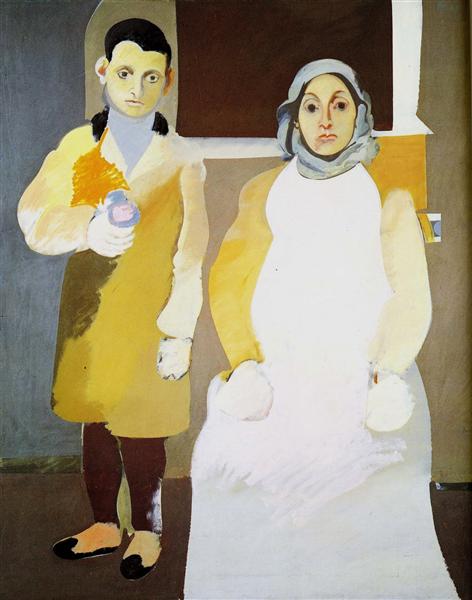
****
Then, music vibrates on and on in my life, where the single transforming moment could be the Butterfield Blues Band’s ground-breaking East-West album, or first hearing John Coltrane’s achingly eloquent and exalting A Love Supreme suite, or his searing Live at Birdland, and imaging being there, in that fire.
 John Coltrane “Live at Birdland.” Courtesy deep groove mono
John Coltrane “Live at Birdland.” Courtesy deep groove mono___
Or, by contrast to such earnest passion, the lacerating sneer of Dylan’s “Like a Rolling Stone” which helped pinpoint the existential waywardness of the freedom my generation declared from bourgeois convention and responsibility. Or, by another contrast, Dylan’s affirmatively flashing “Chimes of Freedom,” poetry aflame in music
Or, hearing Beethoven or Mahler in fearless, heaving performances, in Milwaukee and Madison. Grammy-winning conductor John DeMain especially unlocked much of Mahler’s glorious might with the Madison Symphony Orchestra, in a full Mahler symphonic cycle in the 1990s and 2000s.
In theater, a darkly, full-chested staging of Macbeth at American Platers Theater, and a thunderbolt-raging King Lear at UW-Milwaukee. So, yes, the commonality here seems an appetite for grand gestures, of many sorts.
***
That’s why I finally must land on the experience of reading Moby-Dick for the first time (as some readers of this blog might’ve guessed). I was already in my ‘40s and, knowing its reputation and having seen Huston’s movie version, I remained unprepared for how inexorably the book swept me away, even though many readers understandably turn back to the shore. And yet, there’s so much you’d miss. Even the cetology I gobbled up like so much krill going down a cavernous throat.
Yet the haunting had begun several decades earlier when I found a copy of the 1930 Random House edition which brought the book to widespread readership.
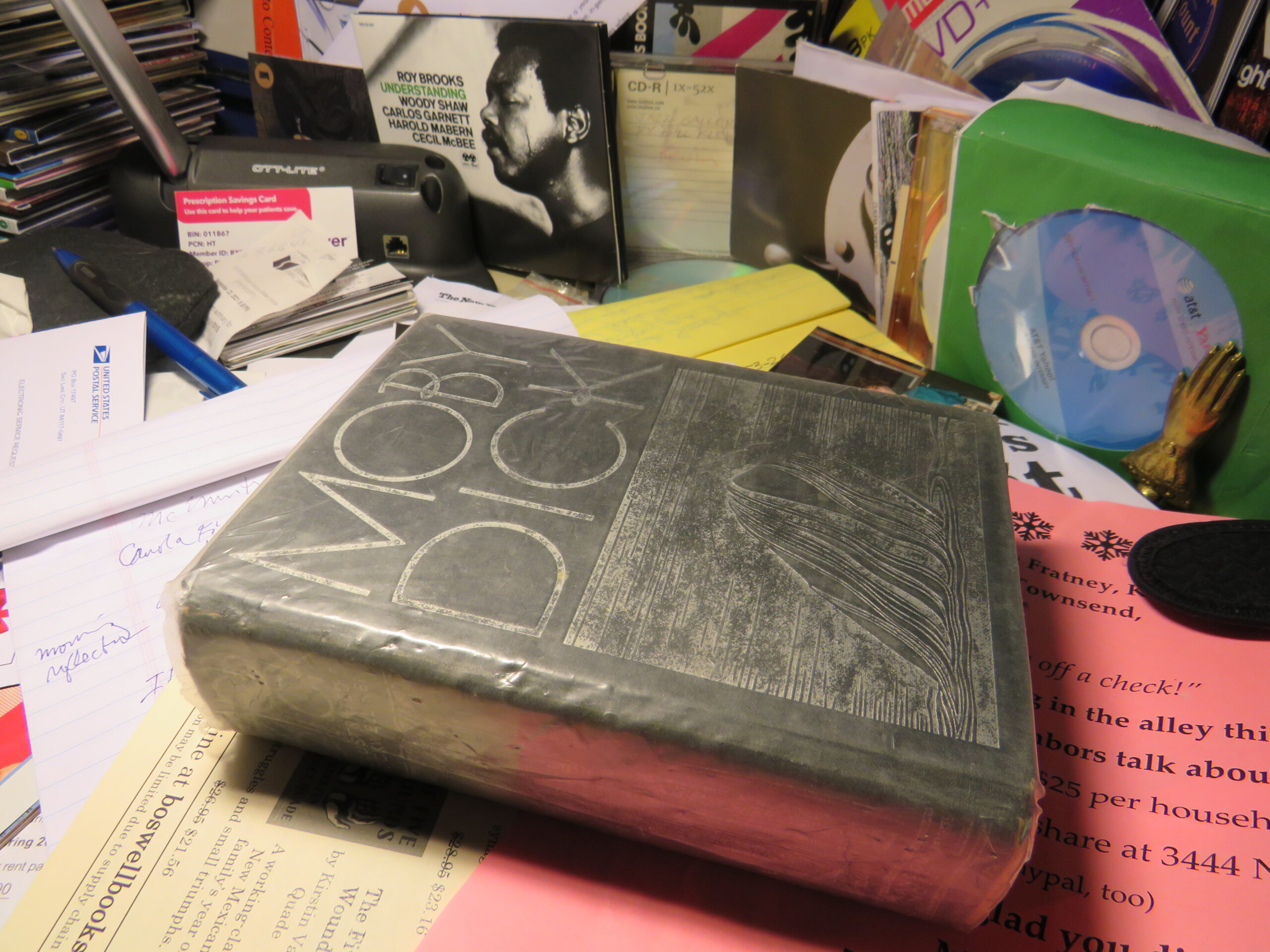
My plastic-covered copy of the 1930 Random House edition of Moby-Dick, what I still believe is the definitive version of an illustrated edition of the book, with art by Rockwell Kent. Photo by Kevin Lynch
___
The visual artist in me responded to this powerfully. I knew then, my day of reckoning with the book loomed somewhere in the future. There have been many illustrated editions of this book since, and some are steeped in their own fiery inspiration. But none so eloquently captures the spirit of the book as it manifest itself in the Depression era, as does that 1930 edition.
Rockwell Kent, in his way, approaches Melville’s genius in his 228 woodblock prints. The black and white Deco-influenced imagery is proto-noir, capturing the sense of lost-at-sea and impending doom and, in deft knife strokes, the essence of characters lurking inside their ravaged, or mortally infected, souls. 3
Infected by what? The blood-lust fervor of Ahab, akin to a demagogue manufacturing an enemy, in the whale that took his leg. The expansively stentorian Ahab, recalling Lear, captivates the whole crew in his questing rage — except for first mate Starbuck and, to a degree, Ishmael, who remains somewhat remote, and “aloft.”
Alas, Random House jumped on their perceived marketing coup with the new edition so strongly that they failed to put Melville’s name anywhere on the cover, only including “Illustrated by Rockwell Kent” on the spine. It was yet another of countless insults to the great and long-forsaken writer, right at the emergence of his genius to broader acceptance. The current Kindle version (at top), at least, corrects that “oversight” with the original cover (colorized though it is).
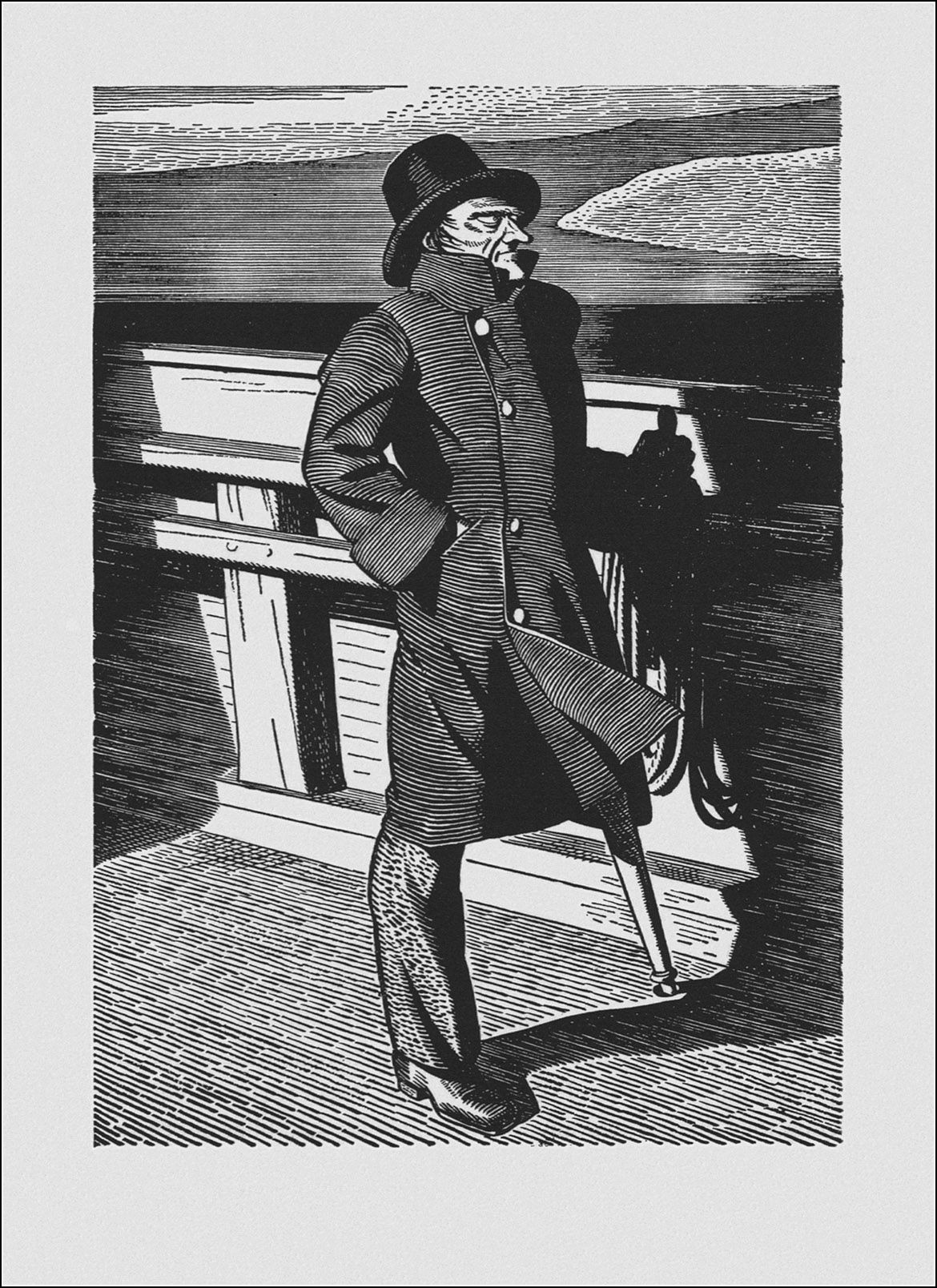
Here’s a brooding but burning portrait of Captain Ahab, by Rockwell Kent.
___
So, back to Melville’s text:
The extraordinarily antiphonal voices of Ishmael and Ahab echoed through my head and psyche, across the oceanic expanses of poetic writing, gritty details, and surprising humor, which might make some virtually sea-sick, but hang onto the horizon as the crow’s nest sways!
It was indeed postmodern in 1851, in how Melville strangely constructed it, and summed up his own creation as well as anyone: “It is the horrible texture of a fabric that should be woven of ships’ cables and hawsers. A Polar wind blows through it, and birds of prey hover over it.”

“Thar she blows!” from “Moby Dick,” 1930, illustrated by Kent. Courtesy “History of Art: Masterpieces of World Literature: Herman Melville.”
___
Yet it persists, remaining afloat as a metaphor and allegory for America, in the tall, creaking bones of The Pequod, manned by people from many races. And what else did it all mean? Defying fate? Or God? Or nature? Or Nature? Hubris as delusion, or the destiny of grace embraced, one storyteller’s backward glance into timelessness?
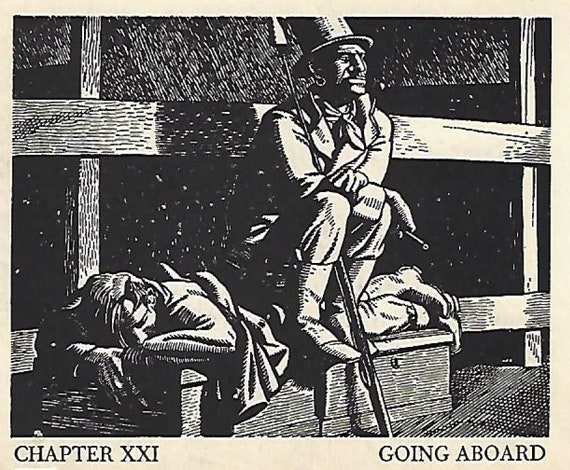
Here, Pequod first harpoonist Queequeg, who deeply befriends Ishmael early in the novel, remains vigilant for the White Whale, even while down in the forecastle where the crew bunks. Illustration by Kent. Courtesy Etsy.
From childhood, oceanic depths had always scared me. In time, Melville’s mounting whorl of words, and his own extraordinary life story, compelled me to begin writing a novel about its author.
These days, people critique the book’s scarcity of women characters. Yet, as Sascha Morrell comments. “On the other hand, the novel makes numerous appeals to the maternal forces of nature. It also breaks down gender norms and boundaries, from Ishmael’s surrender to Queequeg’s ‘bridegroom clasp,’ to Ahab’s boasting of his ‘queenly personality’ to the ambiguous mingling of ‘milk and sperm’ in the infamously erotic chapter ‘A Squeeze of the Hand.’”
Another she doesn’t mention is one of my favorite chapters, the stunning awe of gigantic maternal nursing in “The Grand Armada.” For that matter, tell (the late) Elizabeth Hardwick, author of a brilliantly concise and empathetic Melville biography, how much it lacks for a human female presence. Or Laurie Robertson-Lorant, author of a comprehensive Melville biography. Or Elizabeth Schultz, the doyenne of visual art about “The Great American Novel.”

Moby Dick breaches like a god reaching for the stars, (or to “kiss the sky,” as Jimi Hendrix would exult in the 1960s). in this image by Kent from 1930.
___
On the other hand, one could quote any number of astute observers on the book’s magnificence: Hardwick, F. O. Matthiessen, Harold Bloom, Leslie Fiedler, Alfred Kazin, and Lewis Mumford all come to mind, worth looking up. Most recently, I revisited D.H. Lawrence on Moby-Dick and he says: “A wonderful, wonderful voyage. And a beauty that is so surpassing only because of the author’s awful flounderings in mystical waters. He wanted to get metaphysically deep. And he got deeper than metaphysics. It is a surpassingly beautiful book, with an awful meaning, and bad jolts.” Read his essay in Studies in Classic American Literature for more. 4
So, living on the Heartland edge of a Great Lake, I remain haunted by this and more, by Saint Elmo’s Fire and the diabolical blood ritual, by Pip seeing God’s foot on the treadle of the loom, by the Catskill Eagle emerging from the woe that is madness, by Ahab’s burning obsession, by the massive will and long, mysterious memory – is it consciousness? — of the white whale and, of course, by Queequeg’s coffin, a miraculous, sacred offering from a brotherly friend, somehow rising, just free of the hellish vortex.
“Now small fowls flew screaming over the yet yawning gulf…”
_________
1 Picasso was adamant that Guernica remain at the Met until Spain re-established a democratic republic. It would not be until 1981, after both the artist’s and Franco’s deaths, that Spanish negotiators were finally able to bring the mural home.
2 Mooradian’s The Many Worlds of Arshile Gorky includes 70 illustrations, a Q& A interview with Willem DeKooning about Gorky, as well as interviews with Alexander Calder, Lee Krasner Pollock, Malcolm Cowley, Reuben Nakian, Barnett Newman, Peter Blume, Meyer Schapiro, Saul Steinberg and other important figures in modern art and criticism.
3 The edition of Moby-Dick with Kent’s illustrations remains in print. I recommend the version with an introduction by Elizabeth Hardwick, published by The Modern Library, in paperback 2000.
4. Studies in Classic American Literature, DH Lawrence, Penguin, 1923, 1977, 159

